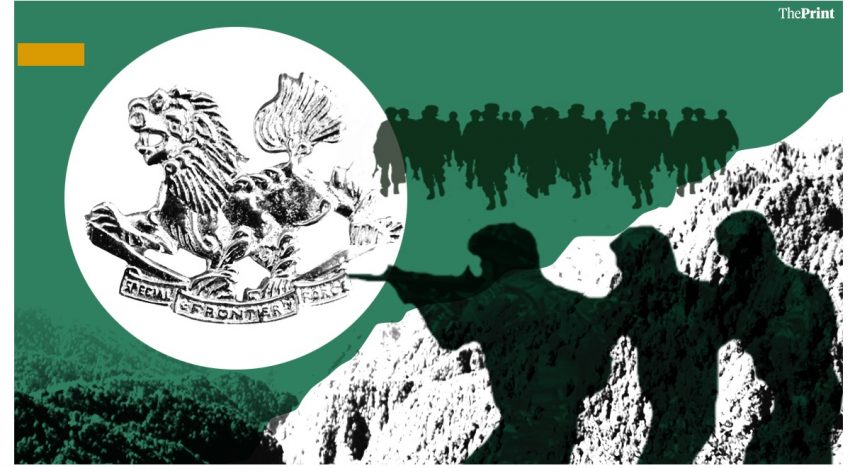The Special Frontier Force was established shortly after the 1962 Sino-Indian War. The world has witnessed the Indian Army’s courage and might numerous times when India’s frontiers have been contested. The army has demonstrated that Mother India’s valiant sons will not tolerate such challenges at any cost. The Army’s Special Frontier Force (SFF) is a vital component. On every front, the Special Frontier Force has demonstrated its might.
Indian Army Intelligence Battalion
 The Thakung and Kala Top peaks on the southern bank of Pagong Lake were captured by the Special Frontier Force of the Indian Army. The Chinese were not allowed to dominate and India is holding at an advantageous position thanks to Special Frontier Force action. There many such stories of SFF bravery.
The Thakung and Kala Top peaks on the southern bank of Pagong Lake were captured by the Special Frontier Force of the Indian Army. The Chinese were not allowed to dominate and India is holding at an advantageous position thanks to Special Frontier Force action. There many such stories of SFF bravery.
It is the intelligence battalion of the Indian Army. Special Frontier Force (SFF) unit is deployed from Uttarakhand to Ladakh on some major high-altitude fronts of the Line of Actual Control (LAC) along the Chinese border.
How Special Frontier Force was formed?
After the Indo-China border war ended in November 1962, Director of Intelligence BN Mullick decided to enlist some Tibetan soldiers. At the period, the Tibetan guerrilla movement was active, and many soldiers and officers were stationed in West Bengal’s Kalimpong or Darjeeling. Malik established touch with Gyalo Thondup, the Dalai Lama’s eldest brother.
He recruited Tibetans from among the refugees who arrived in India after 1959 during the next six months. He had six-seven thousand Tibetans at the time who desired to return to Tibet and be liberated from Chinese control. A party of recruits visited many Tibetan communities, and each young Tibetan expressed an eagerness to fight for Tibet, but that goal was never realised.
Tibetan troops have never fought China. Thus, the Special Frontier Force was established shortly after the 1962 Sino-Indian War. It was initially named as the 22 Battalion and recruited primarily Tibetans. It was dubbed the 22 Battalion after Major General Sujan Singh Uban, the 22 Mountain Regiment’s artillery officer and the SFF’s first Inspector General. Gurkhas are now being recruited alongside Tibetans.
The Indian Army’s Special Frontier Force conquered the Thakung and Kala Top peaks on the southern bank of Pagong Lake. Chinese dominance has been thwarted, and India maintains an advantageous position as a result of Special Frontier Force activities. There are numerous examples of SFF bravery.
It is the Indian Army’s intelligence battalion. From Uttarakhand to Ladakh, a Special Frontier Force (SFF) unit is posted along several main high-altitude fronts of the Line of Actual Control (LAC) along the Chinese border.
How Special Frontier Force was formed?
He recruited Tibetans from among the refugees who arrived in India after 1959 during the next six months. He had six-seven thousand Tibetans at the time who desired to return to Tibet and be liberated from Chinese control. A party of recruits visited many Tibetan communities, and each young Tibetan expressed an eagerness to fight for Tibet, but that goal was never realised. The battalion is subordinate to the cabinet secretariat.
The Special Frontier Force was eventually absorbed into the Indian Army and renamed the Development Battalion. This battalion has been transferred to the Cabinet Secretariat, where it is led by an Inspector General (Security), a Major General in the Army. DGS has been absorbed into India’s foreign intelligence organisation RAW. The SFF’s development battalions are referred to as the Development Battalion. Dalbir Singh, a former Army Chief General, led it once upon a time during his tenure.
Are SFF Units a part of the Army?
The reality is that SFF units are not part of the army but they function under the army. These units have their rank structures but are equal to the ranks of the army. Battalion personnel is so highly trained that they can perform a variety of tasks that a ‘Special Force Unit’ is normally capable of doing. Therefore SFF units function as any other army unit in operational areas despite having a separate charter and history. They have their training institute, where special forces are trained in SFF.
Incidentally, women soldiers also form part of these units and perform special tasks. SFF units have also taken part in several covert operations. These include the 1971 war with Pakistan, Operation Blue Star at the Golden Temple Amritsar, the Kargil conflict, and the counter-terrorism operations in the country. Apart from this, many other operations cannot be disclosed. Helped the Indian Army in 1971 war also
SFF units neutralized the Pakistani Army in the Chittagong Hill Tracts of East Pakistan (now Bangladesh) in 1971 and helped the Indian Army advance. The code name of this operation was ‘Operation Eagle’. Members of the battalion risked going into enemy areas and destroyed the communication system of the Pakistani Army. He also played an important role in preventing Pakistani army personnel from Bangladesh fleeing into Burma (now Myanmar).




